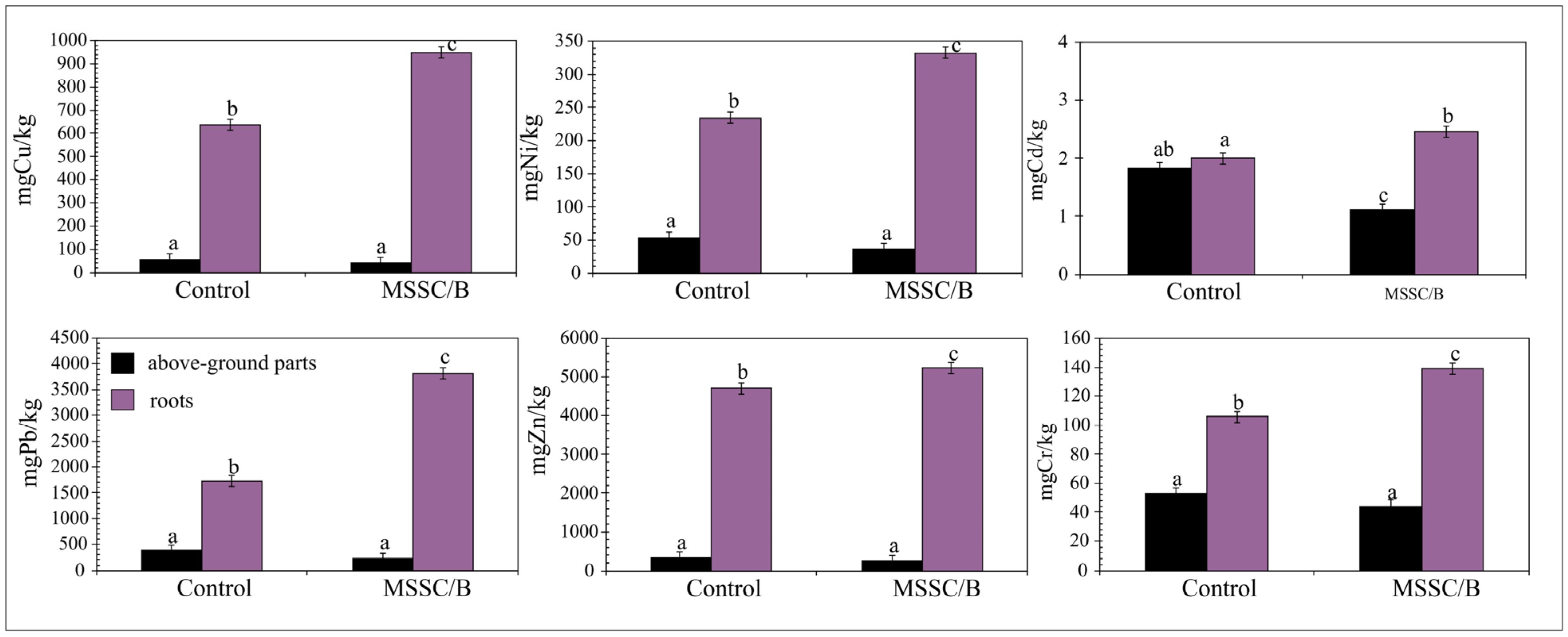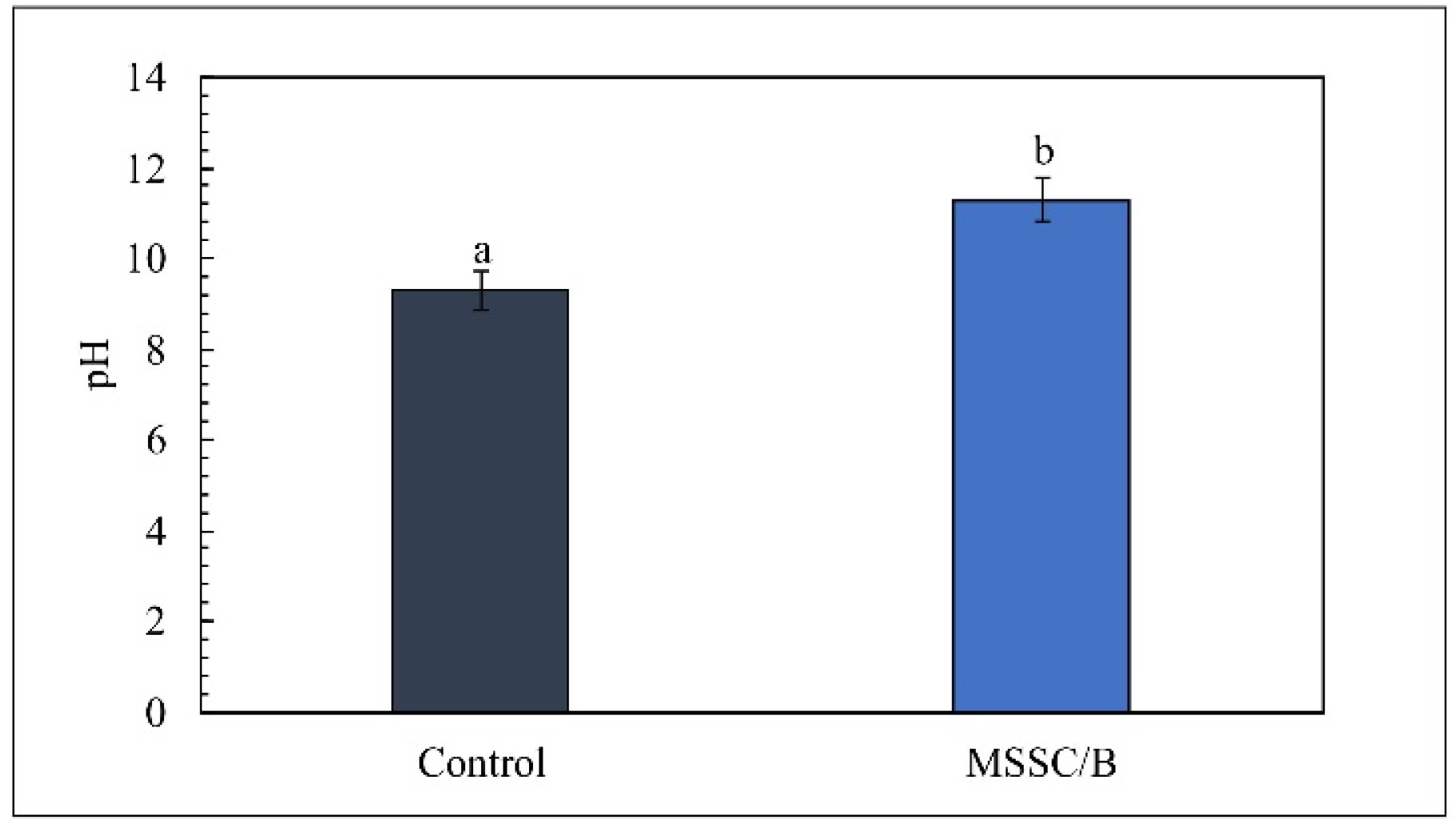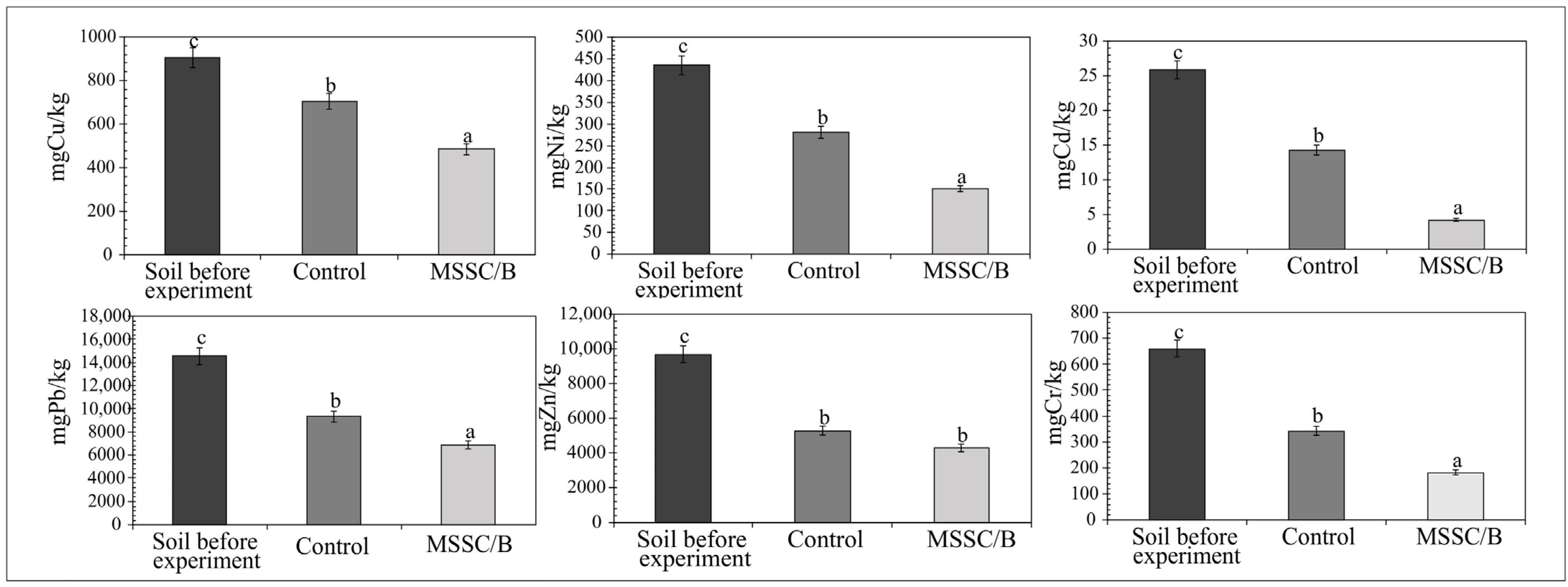Composite Biochar with Municipal Sewage Sludge Compost—A New Approach to Phytostabilization of PTE Industrially Contaminated Soils
Abstract
1. Introduction
2. Materials and Methods
2.1. MSSC/B Properties and Characterization
2.2. Soil Collection and Preparation
2.3. Experiment Design
2.4. Determination of Physico-Chemical Parameters in Plants, Soil, and MSSC/B
2.5. Statistical Analyses
3. Results
3.1. Effect of MSSC/B on D. Glomerata Growth
3.2. PTEs Contents in D. Glomerata following MSSC/B Application
3.3. Soil pH after MSSC/B Application
3.4. PTEs Content in the Soil after MSSC/B Application
4. Discussion
5. Conclusions
Author Contributions
Funding
Data Availability Statement
Conflicts of Interest
References
- González-Guzmán, R.; Inguaggiato, C.; Brusca, L.; González-Acevedo, Z.I.; Bernard-Romero, R. Assessment of potentially toxic elements (PTEs) sources on soils surrounding a fossil fuel power plant in a semi-arid/arid environment: A case study from the Sonoran Desert. Appl. Geochem. 2022, 136, 105158. [Google Scholar] [CrossRef]
- Adimalla, N.; Qian, H.; Nandan, M.J.; Hursthouse, A.S. Potentially toxic elements (PTEs) pollution in surface soils in a typical urban region of south India: An application of health risk assessment and distribution pattern. Ecotoxcol. Environ. Saf. 2020, 203, 111055. [Google Scholar] [CrossRef] [PubMed]
- Kowalska, A.; Grobelak, A.; Almås, A.R.; Singh, B.R. Effect of Biowastes on Soil Remediation, Plant Productivity and Soil Organic Carbon Sequestration: A Review. Energies 2020, 13, 5813. [Google Scholar] [CrossRef]
- Chen, L.; Beiyuan, J.; Hu, S.; Zhang, Z.; Duan, C.; Cui, Q.; Zhu, X.; He, H.; Huang, X.; Fang, L. Phytoremediation of potentially toxic elements (PTEs) contaminated soils using alfalfa (Medicago sativa L.): A comprehensive review. Chemosphere 2022, 293, 133577. [Google Scholar] [CrossRef]
- Durante-Yánez, E.V.; Martínez-Macea, M.A.; Enamorado-Montes, G.; Combatt Caballero, E.; Marrugo-Negrete, J. Phytoremediation of Soils Contaminated with Heavy Metals from Gold Mining Activities Using Clidemia sericea D. Don. Plants 2022, 11, 597. [Google Scholar] [CrossRef]
- Petrova, S.; Nikolov, B.; Velcheva, I.; Angelov, N.; Valcheva, E.; Katova, A.; Golubinova, I.; Marinov-Serafimov, P. Buffer Green Patches around Urban Road Network as a Tool for Sustainable Soil Management. Land 2022, 11, 34. [Google Scholar] [CrossRef]
- Gołda, S.; Korzeniowska, J. Comparison of phytoremediation potential of three grass species in soil contaminated with cadmium. Environ. Prot. Nat. Res. 2016, 27, 8–14. [Google Scholar] [CrossRef]
- Xiao, F.; Gu, Z.; Sarkissian, A.; Ji, Y.; Yang, R.; Yang, L.; Zeng, Q.; Huang, P.; Chen, H. Phytoremediation of potentially toxic elements in a polluted industrial soil using Poinsettia. Physiol. Mol. Biol. Plants 2021, 27, 675–686. [Google Scholar] [CrossRef]
- Radziemska, M.; Gusiatin, Z.M.; Bęś, A.; Czajkowska, J.; Mazur, Z.; Hammerschmiedt, T.; Sikorski, Ł.; Kobzova, E.; Klik, B.K.; Sas, W.; et al. Can the application of municipal sewage sludge compost in the aided phytostabilisation technique provide an effective waste management method? Energies 2021, 14, 1984. [Google Scholar] [CrossRef]
- Zakari, A.; Audu, A.A. Accumulation and Translocation of Potentially Toxic Elements (PTEs) from Industrial Soil by a Woody Drought Tolerant Tree, Eucalyptus citridora. Chem. Search. J. 2021, 1, 112–119. [Google Scholar]
- Heckenroth, A.; Prudent, P.; Folzer, H.; Rabier, J.; Criquet, S.; Saatkamp, A.; Salducci, M.D.; Vassalo, L.; Laffont-Schwob, I. Coronilla juncea, a native candidate for phytostabilization of potentially toxic elements and restoration of Mediterranean soils. Sci. Rep. 2022, 12, 10033. [Google Scholar] [CrossRef] [PubMed]
- Scattolin, M.; Peuble, S.; Pereira, F.; Paran, F.; Moutte, J. Aided-phytostabilization of steel slag dumps: The key role of pH adjustment in decreasing chromium toxicity and improving manganese, phosphorus and zinc phytoavailability. J. Hazard. Mat. 2021, 405, 124225. [Google Scholar] [CrossRef] [PubMed]
- Fronczyk, J.; Radziemska, M.; Mazur, Z. Copper removal from contaminated groundwater using natural and engineered limestone sand in permeable reactive barriers. Fres. Environ. Bull. 2015, 24, 228–234. [Google Scholar]
- Wyszkowski, M.; Radziemska, M. Influence of chromium (III) and (VI) on the concentration of mineral elements in oat (Avena sativa L.). Fres. Environ. Bull. 2013, 22, 979–986. [Google Scholar]
- Sigua, G.C.; Novak, J.N.; Watts, D.W.; Ippolito, J.A.; Ducey, T.H.; Johnson, M.G.; Spokas, K.A. Phytostabilization of Zn and Cd in Mine Soil Using Corn in Combination with Biochars and Manure-Based Compost. Environments 2019, 6, 69. [Google Scholar] [CrossRef]
- Mathiyazhagan, N.; Ying, Y. Influences of Biochar on Bioremediation/Phytoremediation Potential of Metal-Contaminated Soils. Front. Microbiol. 2022, 13, 929730. [Google Scholar] [CrossRef]
- Ghosh, D.; MaitiM, S.K. Biochar assisted phytoremediation and biomass disposal in heavy metal contaminated mine soils: A review. Int. J. Phytoremediat. 2021, 23, 559–576. [Google Scholar] [CrossRef]
- Urbaniak, M.; Wyrwicka, A.; Kiedrzyńska, E.; Staniak, S.; Gałązka, A.; Tołoczko, W.; Siebielec, G. Issues of biological and agricultural treatment of municipal sewage sludge. Acta Innov. 2014, 12, 35–47. [Google Scholar]
- Latosińska, J.; Turdakow, A. Thermal utilization of municipal sewage sludge—Examples of Polish solutions. Struct. Environ. 2011, 3, 31–37. [Google Scholar]
- Longo, S.; Katsou, E.; Malamis, S.; Frison, N.; Renzi, D.; Fatone, F. Recovery of volatile fatty acids from fermentation of sewage sludge in municipal wastewater treatment plants. Biores. Technol. 2015, 175, 436–444. [Google Scholar] [CrossRef]
- Chu, S.; Wu, D.; Liang, L.L.; Zhong, F.; Hu, Y.; Hu, X.; Lai, C.; Zeng, S. Municipal sewage sludge compost promotes Mangifera persiciforma tree growth with no risk of heavy metal contamination of soil. Sci. Rep. 2017, 7, 13408. [Google Scholar] [CrossRef] [PubMed]
- Dzulkurnain, Z.; Hassan, M.A.; Zakaria, M.R.; Wahab, P.E.M.; Hasan, N.Y.; Shirai, Y. Co-composting of Municipal Sewage Sludge and Landscaping Waste: A Pilot Scale Study. Waste Biomass Valorization 2017, 8, 695–705. [Google Scholar] [CrossRef]
- Bożym, M.; Siemiątkowski, G. Characterization of composted sewage sludge during the maturation process: A pilot scale study. Environ. Sci. Pollut. Res. Int. 2018, 25, 34332–34342. [Google Scholar] [CrossRef]
- Storoshchuk, U.; Malovanyy, M.; Tymchuk, I. Substrates based on composted sewage sludge for land recultivation. Ecol. Quest. 2022, 33, 1–16. [Google Scholar] [CrossRef]
- Nissim, W.G.; Cincinelli, A.; Martellini, T.; Alvisi, L.; Palm, E.; Mancuso, S.; Azzarello, E. Phytoremediation of sewage sludge contaminated by trace elements and organic compounds. Environ. Res. 2018, 164, 356–366. [Google Scholar] [CrossRef] [PubMed]
- Muter, O.; Dubova, L.; Kassien, O.; Cakane, J.; Alsina, I. Application of the Sewage Sludge in Agriculture: Soil Fertility, Techno-economic, and Life-Cycle Assessment. Hazard. Waste Manag. 2022. [Google Scholar] [CrossRef]
- Polish Ministry of the Environment. Ordinance of the Minister of Environment on Soil and Ground Quality Standards; Jew Lawyer; Polish Ministry of the Environment: Warsaw, Poland, 2016; Volume 395, pp. 1–86. (In Polish) [Google Scholar]
- Nawrot, N.; Wojciechowska, E.; Pazdro, K.; Szmagliński, J.; Pempkowiak, J. Uptake, accumulation, and translocation of Zn, Cu, Pb, Cd, Ni, and Cr by P. australis seedlings in an urban dredged sediment mesocosm: Impact of seedling origin and initial trace metal content. Sci. Tot. Environ. 2021, 768, 144983. [Google Scholar] [CrossRef]
- Shaheen, S.M.; Shams, M.S.; Khalifa, M.R.; El-Dali, M.A.; Rinklebe, J. Various soil amendments and environmental wastes affect the (im)mobilization and phytoavailability of potentially toxic elements in a sewage effluent irrigated sandy soil. Ecotoxicol. Environ. Saf. 2017, 142, 375–387. [Google Scholar] [CrossRef]
- Zuo, W.; Gu, C.; Zhang, W.; Xu, K.; Wang, Y.; Bai, Y.; Shan, Y.; Dai, Q. Sewage sludge amendment improved soil properties and sweet sorghum yield and quality in a newly reclaimed mudflat land. Sci. Tot. Environ. 2019, 654, 541–549. [Google Scholar] [CrossRef]
- Tammam, A.; El-Aggan, W.; Abou-Shanab, R.; Mubarak, M. Improved of growth and phytostabilization potential of lead (Pb) in Glebionis coronaria L. under the effect of IAA and GA3 alone and in combination with EDTA by altering biochemical attributes of stressed plants. Int. J. Phytorem. 2021, 23, 958–968. [Google Scholar] [CrossRef]
- Radziemska, M.; Vaverková, M.D.; Mazur, Z. Pilot scale use of compost combined with sorbents to phytostabilize Ni-contaminated soil using Lolium Perenne L. Waste Biomass Valorization 2019, 10, 1585–1595. [Google Scholar] [CrossRef]
- Ho, T.T.K.; Tra, V.T.; Le, T.H.; Nguyen, N.K.Q.; Tran, C.S.; Nguyen, P.T.; Vo, T.D.H.; Thai, V.N.; Bui, X.T. Compost to improve sustainable soil cultivation and crop productivity. Case Stud. Chem. Environ. Eng. 2022, 6, 100211. [Google Scholar] [CrossRef]
- Chen, X.; Wang, J.; Hayat, K.; Zhang, D.; Zhou, P. Small structures with big impact: Multi-walled carbon nanotubes enhanced remediation efficiency in hyperaccumulator Solanum nigrum L. under cadmium and arsenic stress. Chemosphere 2021, 276, 130130. [Google Scholar] [CrossRef] [PubMed]
- Kutlu, O.; Kocar, G. Biochar from residual biomass in Turkey, and the possibility of return to the soil: An estimation of the supply and demand. Pol. J. Agronom. 2017, 30, 10–24. [Google Scholar]
- Dietrich, C.C.; Rahaman, M.A.; Robles-Aguilar, A.A.; Latif, S.; Intani, K.; Müller, J.; Jablonowski, N.D. Nutrient Loaded Biochar Doubled Biomass Production in Juvenile Maize Plants (Zea mays L.). Agronomy 2020, 10, 567. [Google Scholar] [CrossRef]
- Gonzaga, M.I.S.; da Silva, P.S.O.; Santos, J.C.J.; de Oliveira Junior, L.F.G. Biochar increases plant water use efficiency and biomass production while reducing Cu concentration in Brassica juncea L. in a Cu-contaminated soil. Ecotoxcol. Environ. Saf. 2019, 183, 109557. [Google Scholar] [CrossRef]
- Batool, A.; Taj, S.; Rashid, A.; Khalid, A.; Qadeer, S.; Saleem, A.R.; Ghufran, M.A. Potential of soil amendments (Biochar and Gypsum) in increasing water use efficiency of Abelmoschus esculentus L. Moench. Front. Plant Sci. 2015, 6, 733. [Google Scholar] [CrossRef]
- Wang, Y.; Li, F.; Song, J.; Xiao, R.; Luo, L.; Yang, Z.; Chai, L. Stabilization of Cd-, Pb-, Cu-and Zn-contaminated calcareous agricultural soil using red mud: A field experiment. Environ. Geochem. Health 2018, 40, 2143–2153. [Google Scholar] [CrossRef]
- Licht, J.; Smith, N. The influence of lignocellulose and hemicellulose biochar on photosynthesis and water use efficiency in seedlings from a Northeastern U.S. pineoak ecosystem. J. Sustain. For. 2017, 37, 25–37. [Google Scholar] [CrossRef]
- Cruz, N.; Rodrigues, S.M.; Coelho, C.; Carvalho, L.; Duarte, A.C.; Pereira, E.; Römkens, P.F.A.M. Urban agriculture in Portugal: Availability of potentially toxic elements for plant uptake. Appl. Geochem. 2014, 44, 27–37. [Google Scholar] [CrossRef]
- Terzano, R.; Rascio, I.; Allegretta, I.; Porfido, C.; Spagnuolo, M.; Khanghahi, M.Y.; Crecchio, C.; Sakellariadou, F.; Gattullo, C.E. Fire effects on the distribution and bioavailability of potentially toxic elements (PTEs) in agricultural soils. Chemosphere 2021, 281, 130752. [Google Scholar] [CrossRef] [PubMed]
- Yousaf, B.; Liu, G.; Abbas, Q.; Wang, R.; Imtiaz, M.; Zia-ur-Rehman, M. Investigating the uptake and acquisition of potentially toxic elements in plants and health risks associated with the addition of fresh biowaste amendments to industrially contaminated soil. Land Degrad. Dev. 2017, 28, 2596–2607. [Google Scholar] [CrossRef]
- Garau, M.; Castaldi, P.; Diquattro, S.; Pinna, M.V.; Senette, C.; Roggero, P.P.; Garau, G. Combining grass and legume species with compost for assisted phytostabilization of contaminated soils. Environ. Technol. Innov. 2021, 22, 101387. [Google Scholar] [CrossRef]
- Zgorelec, Z.; Bilandzija, N.; Knez, K.; Galic, M.; Zuzul, S. Cadmium and Mercury phytostabilization from soil using Miscanthus × giganteus. Sci. Rep. 2020, 10, 6685. [Google Scholar] [CrossRef] [PubMed]
- Zhang, X.; Zhang, X.; Huang, K. Phytostabilization of Acidic Soils with Heavy Metal Contamination Using Three Forage Grasses in Combination with Organic and Inorganic Amendments. Soil Sedim. Contam. Int. J. 2016, 25, 459–475. [Google Scholar] [CrossRef]
- Palansooriya, K.N.; Shaheen, S.M.; Chen, S.S.; Tsang, D.C.W.; Hashimoto, Y.; Hou, D.; Bolan, N.S.; Rinklebe, J.; Ok, Y.S. Soil amendments for immobilization of potentially toxic elements in contaminated soils: A critical review. Environ. Int. 2020, 134, 105046. [Google Scholar] [CrossRef]
- Pavlović, P.; Sawidis, T.; Breuste, J.; Kostić, O.; Čakmak, D.; Đorđević, D.; Pavlović, D.; Pavlović, M.; Perović, V.; Mitrović, M. Fractionation of Potentially Toxic Elements (PTEs) in Urban Soils from Salzburg, Thessaloniki and Belgrade: An Insight into Source Identification and Human Health Risk Assessment. Int. J. Environ. Res. Public Health 2021, 3, 6014. [Google Scholar] [CrossRef]
- Achour, Y.; Souissi, R.; Tlil, H.; Souissi, F.; Motelica-Heino, M. Mobility of Potentially Toxic Elements (Pb, Zn, Cd, As, Sb) in Agricultural Carbonated Soils Contaminated by Mine Tailings (Northern Tunisia): A New Kinetic Leaching Approach with Organic Acids. Water 2022, 14, 3337. [Google Scholar] [CrossRef]
- Gil-Loaiza, J.; White, S.A.; Root, R.A.; Solís-Dominguez, F.A.; Hammond, C.M.; Chorover, J.; Maier, R.M. Phytostabili-zation of mine tailings using compost-assisted direct planting: Translating greenhouse results to the field. Sci. Total Environ. 2016, 565, 451–461. [Google Scholar] [CrossRef]




| Characteristic | Unit | MSSC | Biochar |
|---|---|---|---|
| Surface area BET | m2/g | 12.5 | 313.73 |
| Total area in pores | m2/g | 1.13 | 92.9 |
| Total volume in pores | cm3/g | 0.011 | 0.113 |
| pH | - | 7.1 ± 0.2 | 10.4 ± 0.3 |
| Electrical conductivity | mS/cm | 12.2 ± 0.4 | 2.9 ± 0.1 |
| Volatile matter | % | 34.7 ± 0.7 | 16.5 ± 0.5 |
| Cation exchange capacity | Cmol/kg | 49.5 ± 1.4 | 48.59 ± 2.3 |
| Cd | mg/kg | 0.8 ± 0.2 | 0.2 ± 0.05 |
| Cr | mg/kg | 55.2 ± 2.8 | 9.6 ± 0.7 |
| Cu | mg/kg | 57.6 ± 7.6 | 13.9 ± 6.3 |
| Ni | mg/kg | 23.4 ± 3.6 | 10.2 ± 0.1 |
| Pb | mg/kg | 8.2 ± 0.8 | 1.1 ± 1.6 |
| Zn | mg/kg | 253.7 ± 18.2 | 200.2 ± 10.7 |
| P2O5 | wt% | 2.57 | 6.01 |
| CaO | wt% | 1.04 | 29.8 |
| SiO2 | wt% | 4.62 | 19.7 |
| Na2O | wt% | 0.93 | 1.1 |
| MgO | wt% | 1.44 | 3.7 |
| K2O | wt% | 0.64 | 14.4 |
| Al2O3 | wt% | 2.2 | 2.5 |
| Fe2O3 | wt% | 3.16 | 3.7 |
Disclaimer/Publisher’s Note: The statements, opinions and data contained in all publications are solely those of the individual author(s) and contributor(s) and not of MDPI and/or the editor(s). MDPI and/or the editor(s) disclaim responsibility for any injury to people or property resulting from any ideas, methods, instructions or products referred to in the content. |
© 2023 by the authors. Licensee MDPI, Basel, Switzerland. This article is an open access article distributed under the terms and conditions of the Creative Commons Attribution (CC BY) license (https://creativecommons.org/licenses/by/4.0/).
Share and Cite
Radziemska, M.; Gusiatin, M.Z.; Mazur, Z.; Radzevičius, A.; Bęś, A.; Šadzevičius, R.; Holatko, J.; Dapkienė, M.; Adamonytė, I.; Brtnicky, M. Composite Biochar with Municipal Sewage Sludge Compost—A New Approach to Phytostabilization of PTE Industrially Contaminated Soils. Energies 2023, 16, 1778. https://doi.org/10.3390/en16041778
Radziemska M, Gusiatin MZ, Mazur Z, Radzevičius A, Bęś A, Šadzevičius R, Holatko J, Dapkienė M, Adamonytė I, Brtnicky M. Composite Biochar with Municipal Sewage Sludge Compost—A New Approach to Phytostabilization of PTE Industrially Contaminated Soils. Energies. 2023; 16(4):1778. https://doi.org/10.3390/en16041778
Chicago/Turabian StyleRadziemska, Maja, Mariusz Zygmunt Gusiatin, Zbigniew Mazur, Algirdas Radzevičius, Agnieszka Bęś, Raimondas Šadzevičius, Jiri Holatko, Midona Dapkienė, Inga Adamonytė, and Martin Brtnicky. 2023. "Composite Biochar with Municipal Sewage Sludge Compost—A New Approach to Phytostabilization of PTE Industrially Contaminated Soils" Energies 16, no. 4: 1778. https://doi.org/10.3390/en16041778
APA StyleRadziemska, M., Gusiatin, M. Z., Mazur, Z., Radzevičius, A., Bęś, A., Šadzevičius, R., Holatko, J., Dapkienė, M., Adamonytė, I., & Brtnicky, M. (2023). Composite Biochar with Municipal Sewage Sludge Compost—A New Approach to Phytostabilization of PTE Industrially Contaminated Soils. Energies, 16(4), 1778. https://doi.org/10.3390/en16041778








